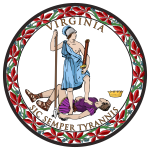
The 18th United States Congress was a meeting of the legislative branch of the United States federal government, consisting of the United States Senate and the United States House of Representatives. It met in Washington, D.C., from March 4, 1823, to March 4, 1825, during the seventh and eighth years of James Monroe's presidency. The apportionment of seats in the House of Representatives was based on the 1820 United States census. Both chambers had a Democratic-Republican majority.

The 19th United States Congress was a meeting of the legislative branch of the United States federal government, consisting of the United States Senate and the United States House of Representatives. It met in Washington, D.C. from March 4, 1825, to March 4, 1827, during the first two years of John Quincy Adams's presidency. The apportionment of seats in the House of Representatives was based on the 1820 United States census. The Senate had a majority of Jackson Men, while the House had an Anti-Jackson (pro-Adams) majority.

Thomas Newton Jr. was an American politician who was a U.S. Representative from Virginia from 1817 until 1830. Union general John Newton was his son.

The 1826–27 United States House of Representatives elections were held on various dates in various states between July 3, 1826, and August 30, 1827. Each state set its own date for its elections to the House of Representatives before the first session of the 20th United States Congress convened on December 3, 1827. They occurred during John Quincy Adams's presidency. Elections were held for all 213 seats, representing 24 states.

The 1824–25 United States House of Representatives elections were held on various dates in various states between July 7, 1824, and August 30, 1825. Each state set its own date for its elections to the House of Representatives before the first session of the 19th United States Congress convened on December 5, 1825. Elections were held for all 213 seats, representing 24 states.

The 1822–23 United States House of Representatives elections were held on various dates in various states between July 1, 1822, and August 14, 1823. Each state set its own date for its elections to the House of Representatives before the first session of the 18th United States Congress convened on December 1, 1823. They occurred during President James Monroe's second term.
Events from the year 1824 in the United States.
Francis White was a distinguished early American lawyer and politician in what was then the U.S. state of Virginia.

The 1824 United States House of Representatives elections in New York were held from November 1 to 3, 1824, to elect 34 U.S. Representatives to represent the State of New York in the United States House of Representatives of the 19th United States Congress.

Pennsylvania elected its members October 12, 1824.

The 1822–23 United States Senate elections were held on various dates in various states. As these U.S. Senate elections were before the ratification of the Seventeenth Amendment in 1913, senators were chosen by state legislatures. Senators were elected over a wide range of time throughout 1822 and 1823, and a seat may have been filled months late or remained vacant due to legislative deadlock. In these elections, terms were up for the senators in Class 2.

The 1824–25 United States Senate Elections were held on various dates in various states. As these U.S. Senate elections were prior to the ratification of the Seventeenth Amendment in 1913, senators were chosen by state legislatures. Senators were elected over a wide range of time throughout 1824 and 1825, and a seat may have been filled months late or remained vacant due to legislative deadlock. In these elections, terms were up for the senators in Class 3.

On March 23, 1824, Hutchins G. Burton (DR), who had represented North Carolina's 2nd district, resigned upon being elected Governor. A special election was held to fill the resulting vacancy on January 6, 1825

Kentucky elected its members August 2, 1824.

New Hampshire elected its members between November 1, 1824 and March 8, 1825. New Hampshire law required candidates to receive votes from a majority of voters for election. As only five candidates received votes from a majority of voters, a run-off election had to be held for the sixth seat on March 8, 1825.

Vermont elected its members September 7, 1824. Congressional districts were re-established in Vermont for the 1824 election. Vermont had used an at-large district 1812-1818 and 1822. A majority was required for election, which was not met in the 1st district, necessitating a second election December 6, 1824.

North Carolina elected its members August 11, 1825 after the term began but before the new Congress convened.

The 1824–1825 United States Senate election in Pennsylvania was held between December 1824 and February 1825. William Marks was elected by the Pennsylvania General Assembly to the United States Senate.

The 1824 United States elections elected the members of the 19th United States Congress. It marked the end of the Era of Good Feelings and the First Party System. The divided outcome in the 1824 presidential contest reflected the renewed partisanship and emerging regional interests that defined a fundamentally changed political landscape. The bitterness that followed the election ensured political divisions would be long-lasting and facilitated the gradual emergence of what would eventually become the Second Party System. Members of the Democratic-Republican Party continued to maintain a dominant role in federal politics, but the party became factionalized between supporters of Andrew Jackson and supporters of John Quincy Adams. The Federalist Party ceased to function as a national party, having fallen into irrelevance following a relatively strong performance in 1812.
Massachusetts elected its members November 1, 1824. Massachusetts had a majority requirement for election, which necessitated additional elections held January 3, 1825, April 1, 1825, and August 1, 1825.














